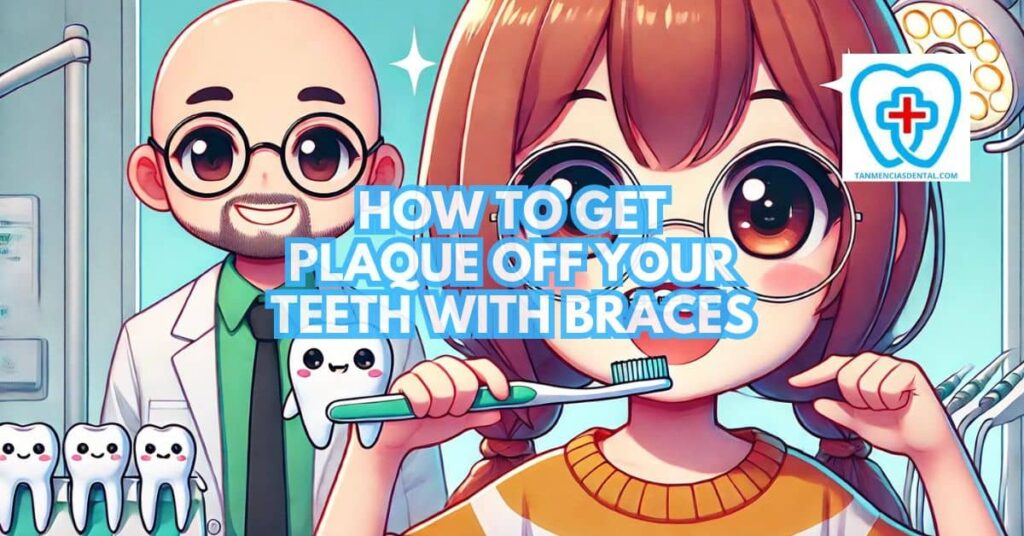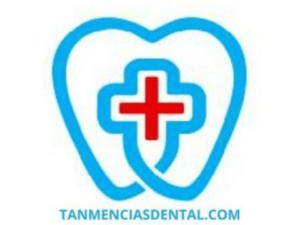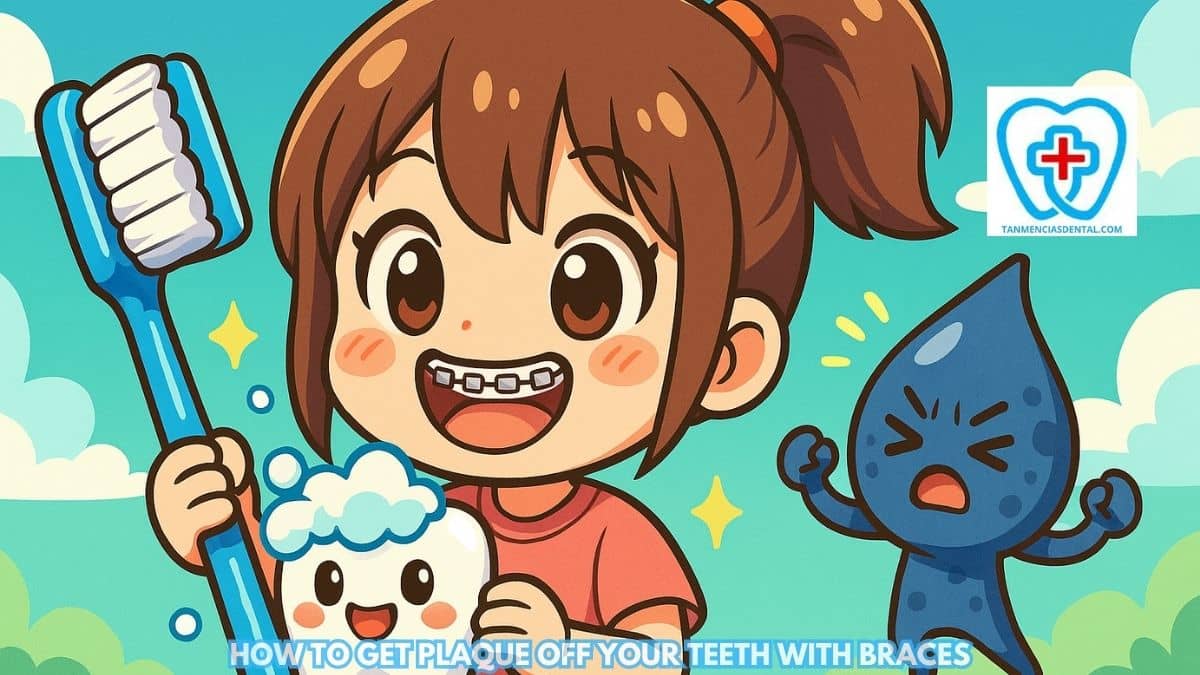Learning how to get plaque off your teeth with braces is an important part of keeping your smile healthy.
Plaque is a sticky layer of bacteria that forms on your teeth every day, and braces make it easier for plaque to hide in hard-to-reach spots.
Without proper cleaning, this buildup can lead to cavities, gum problems, and white spots on your teeth.
Understanding the right tools and habits makes it much easier to keep your teeth and braces clean.
With regular care and attention, you can prevent plaque from causing damage and enjoy a bright, healthy smile throughout your orthodontic treatment.
1. Brush Your Way to a Brighter Smile
Brushing effectively with braces takes time and the right method to reach every part of your teeth.
Use a soft-bristled toothbrush and hold it at a 45-degree angle toward the gum line to clean under and around the brackets.
Spend extra time brushing each tooth carefully, especially near the gums, where food and plaque often collect.
Move the brush in small circles to loosen plaque and remove trapped food.
Electric toothbrushes can make this easier because they move consistently and reach tight spaces more effectively.
Brush for at least two minutes, twice a day, to lower the risk of buildup and irritation.
Paying attention to the gum line and brushing gently but thoroughly is one of the best steps for keeping your teeth clean while wearing braces.
🦷 Exploring the Benefits of Angled Toothbrushes
2. Floss Like a Pro: Conquering Tight Spaces
Flossing with braces can be tricky because the wires make it hard to reach between your teeth.
To clean effectively around your braces, use a floss threader or orthodontic floss that can slide under the wires.
Move the floss gently up and down along each tooth and under the gum line to remove hidden food and plaque.
Be patient and take your time so you do not hurt your gums or damage the wires.
Daily flossing is one of the best ways to stop bacteria from causing cavities and gum problems.
It helps prevent swelling, bleeding, and buildup that regular brushing might miss.
Keeping up with this habit will protect your gums and make your orthodontic treatment more successful.
🦷 What Makes the Best Teeth Whitening Courses Stand Out from Others?
3. Interdental Brushes: The Unsung Hero
Interdental brushes are small, pointed brushes designed to clean between teeth and around braces.
They can reach spots that are difficult for regular toothbrushes, making them ideal for cleaning around brackets and wires.
Use them gently to avoid damaging your braces while effectively removing plaque and food debris.
Interdental brushes are especially useful for cleaning the areas next to the brackets where plaque tends to build up.
Incorporating these brushes into your daily routine can significantly improve your oral hygiene while wearing braces.
🦷 How to Reduce the Swelling After Wisdom Teeth Removal
4. Power Up Your Oral Care with a Water Flosser
A water flosser is a valuable tool for anyone with braces, as it uses a stream of pulsating water to clean around brackets and between teeth.
This device is effective at removing food particles and plaque from hard-to-reach areas that traditional flossing might miss.
Using a water flosser is easy and can be less time-consuming than manual flossing, making it a convenient option for maintaining oral hygiene.
It is important to adjust the water pressure to a comfortable level and direct the stream along the gumline and between teeth for the best results.
Incorporating a water flosser into your daily routine can enhance your oral care and help keep your teeth and gums healthy during orthodontic treatment.
🦷 What Is the Best Way to Brush Your Teeth with Braces?

5. Choose the Right Toothpaste for Braces
Picking the best toothpaste while wearing braces helps protect your teeth and keep your mouth healthy.
Choose a toothpaste with fluoride because it strengthens enamel and helps prevent problems that can cause tooth decay.
Fluoride also helps rebuild weak spots on the teeth that may form under the brackets.
Avoid whitening toothpaste because it can make the areas under your braces look darker once they are removed.
Look for toothpaste that fights bacteria in plaque, as this can lower your risk of gum irritation and bad breath.
Some toothpastes also contain gentle ingredients that reduce sensitivity and protect the gums.
Using the right toothpaste every day supports your brushing routine and keeps your teeth strong and clean throughout your orthodontic treatment.
🦷 What are Some Surprising Natural Ways to Treat Gingivitis?
6. Rinse-Away Plaque with Mouthwash
Mouthwash can be a powerful ally in the fight against plaque, providing an extra layer of protection beyond brushing and flossing.
Antimicrobial mouthwash helps reduce the bacteria that cause plaque and gum disease, while fluoride mouthwash offers additional cavity protection.
Rinsing with mouthwash for 30 seconds after brushing and flossing can help reach areas in the mouth that brushing alone might miss, ensuring a more thorough clean.
Be sure to choose an alcohol-free mouthwash to avoid drying out your mouth, which can lead to other oral health issues.
Incorporating mouthwash into your daily routine can significantly improve your oral hygiene while wearing braces.
🦷 Dangers of Electric Toothbrushes: Are They Worth the Hype?
7. Keep Your Mouth Moist to Reduce Plaque
Dry mouth makes it easier for plaque to build up because there is less saliva to wash away food and bacteria.
Drinking plenty of water throughout the day helps keep your mouth clean and comfortable.
Choose alcohol-free mouthwash since alcohol can dry your mouth and make plaque worse.
Chewing sugar-free gum or using xylitol mints can help stimulate your mouth to produce more saliva.
If you often breathe through your mouth or take medicine that causes dryness, ask your dentist or doctor for ways to keep your mouth moist and healthy.
🦷 Special Needs And Dental Checkups
8. Regular Checkups: The Key to Oral Health
Regular dental visits are an important part of keeping your teeth and gums healthy during orthodontic treatment.
These checkups allow your dentist to clean areas that are difficult to reach with braces and remove hardened plaque.
They also help find problems like early tooth decay or gum swelling before they become serious.
Your orthodontist will review the position of your teeth, tighten or adjust your braces, and make sure everything is moving as planned.
Routine visits also give you a chance to ask questions about cleaning tools or products for brace care.
By following your dentist’s and orthodontist’s advice, you can keep your teeth strong and ensure your orthodontic treatment stays on track.
🦷 How Recycled Toothbrushes Support Zero-Waste Lifestyle Goals
9. Fuel Your Smile: Diet and Oral Hygiene
Your diet plays a significant role in maintaining oral health, especially when wearing braces.
Foods high in sugar and starch can increase plaque buildup and lead to cavities, so it’s essential to limit these in your diet.
Sticky and hard foods should also be avoided, as they can damage braces or get lodged in the wires and brackets.
Instead, opt for a balanced diet rich in fruits, vegetables, lean proteins, and dairy products, which support strong teeth and gums.
Staying hydrated by drinking plenty of water also helps wash away food particles and keeps your mouth healthy.
🦷 What is a Good Alternative to a Toothbrush for Maintaining Oral Hygiene?
10. Preventing White Spots: A Bright Smile Goal
White spots on teeth often appear when plaque weakens the enamel during orthodontic treatment.
These marks form when a thin film of bacteria stays on the teeth for too long, leading to a loss of minerals from the enamel surface.
To prevent this, brush carefully around the brackets and along the gum line where plaque tends to collect.
Using fluoride toothpaste and mouthwash helps rebuild the enamel and protects your teeth from early damage.
Visiting your dentist regularly allows for professional cleanings that remove hardened buildup before it causes lasting marks.
It is also helpful to limit sugary snacks and drinks that feed the bacteria responsible for demineralization.
With steady cleaning and regular checkups, you can avoid white spots and keep your smile smooth and bright.
11. Maintaining Oral Health with Retainers
When your braces come off, wearing a retainer is the next important step to keep your teeth in their new positions.
The retainer holds your teeth steady while the surrounding gums and bone adjust to their new alignment.
Clean your retainer every day by brushing it gently with a soft toothbrush and rinsing it with mild soap and cool water.
Avoid using hot water because it can damage the shape of the retainer and make it uncomfortable to wear.
Always store it in a protective case when it is not in your mouth to prevent it from getting lost or broken.
Continue practicing good oral hygiene by brushing and flossing daily to remove plaque and keep your mouth healthy.
With proper care for both your teeth and retainer, your smile will stay straight, clean, and strong long after your braces come off.
👨⚕️ Conclusion
Maintaining a plaque-free smile with braces requires dedication and the right tools.
By incorporating effective brushing and flossing techniques, using specialized tools like interdental brushes and water flossers, and making wise dietary choices, you can keep your teeth and gums healthy.
Regular dental checkups and a focus on proper oral hygiene will help prevent issues like cavities and white spots.
Once your braces are off, continued care with retainers and good habits will ensure your smile stays bright and healthy.
With these strategies, you can enjoy a successful orthodontic journey and a beautiful, lasting smile.
😊 Self-Promotion
Discover a brighter, healthier smile at Tan-Mencias Dental Clinic in Parang, Marikina City!
Our dedicated team is ready to provide exceptional dental care in a welcoming and comfortable environment.
Whether you have questions or need to schedule an appointment, feel free to reach out to us by calling 09171451074, sending a message through our Facebook page, or using our website’s contact form.
We are committed to ensuring you receive the best possible care and are here to address any concerns you may have.
Visit us today and experience the friendly, personalized service that sets us apart!
❔ FAQs
1. How often should I brush my teeth when I have braces?
You should brush your teeth at least twice a day, and it is even better to brush after every meal.
This helps remove food and plaque trapped around brackets and wires.
Make sure to spend at least two minutes brushing carefully.
A soft toothbrush or an electric one works best for cleaning around braces.
2. Can I use regular floss with braces?
Regular floss can be difficult to use with braces because the wires block easy access between teeth.
It is better to use a floss threader or orthodontic floss designed for braces.
These tools help you clean around wires and remove plaque from tight spaces.
Daily flossing is important to keep your gums healthy and prevent cavities.
3. What foods should I avoid to reduce plaque buildup with braces?
Avoid sticky, chewy, or hard foods such as gum, caramel, popcorn, and nuts.
These foods can get stuck in braces and make plaque harder to clean off.
Try to limit sugary snacks and drinks that cause bacteria to grow.
Choose soft fruits, cooked vegetables, and dairy products that are gentle on your teeth and braces.
4. Why does my mouth feel dry when I wear braces?
Braces can make it harder for your mouth to stay moist, and some medicines or mouth breathing can cause dry mouth too.
Saliva helps wash away food and plaque, so dry mouth can lead to more buildup.
Drink plenty of water throughout the day and use alcohol-free mouthwash.
Sugar-free gum or xylitol mints can also help your mouth produce more saliva.
5. How can I prevent white spots on my teeth after braces?
White spots form when plaque weakens the enamel on your teeth.
To prevent them, brush carefully around every bracket and along the gumline.
Use fluoride toothpaste and mouthwash to strengthen your enamel.
Visit your dentist regularly for professional cleanings and early treatment if white spots begin to appear.

